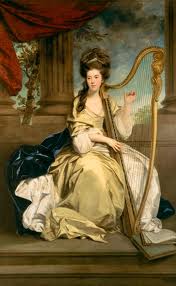Annotation:Lady Eglintoune
Back to Lady Eglintoune
LADY EGLINTOUNE. Scottish, Reel. C Major. Standard tuning (fiddle). AAB. John Glen (1891) finds the earliest appearance of this tune in print in John Riddell's 1782 collection (p. 41), a second edition of his "greatly improved" first edition of c. 1766. The reel had also been published a few years earlier than Riddell's second edition by fiddler-composer Robert Ross in his Choice Collection (Edinburgh, 1780). The Menzies Manuscript (1749) contains a dance called The Montgomeries' Rant which is set to the reel "Lady Eglintoun" by the RSCDS.

The Ayrshire Eglintouns are of clan Montgomery. There are a few "Lady Eglintouns" (Eglinton) to choose from regarding the person honored by Riddell's title. The tall and lovely Susanna Montgomery, Countess of Eglinton (1690-1780) was the third wife of Alexander Montgomerie, 9th Earl of Eglinton, whom she outlived by fifty years. She was celebrated for her beauty and her patronage of the Scottish poets and writers of her day. Allan Ramsay's The Gentle Shepherd (1725) was dedicated to her. Her son, Alexander, the 10th Earl, was killed in 1769 in a dispute with a customs officer about bearing arms on the Earl's grounds. Alexander married Susanna Kennedy, who died at Auchans, Ayrshire, in 1780, aged 91. The 10th Earl, Archibald Montgomery (1726-1796), another of Susanna Montgomery's sons, was a Scottish General and politician, and a patron of poet Robert Burns. His first wife was Lady Jean/Jane Lindsay, whom he married in 1772 but who died in 1788 without issue. Secondly he married Frances Twysden, whom he divorced in 1788 on account of her affair with Douglas Hamilton, 8th Duke of Hamilton with whom she allegedly had a daughter. As a result, between Riddell's 1766 and 1782 collections there are three 'Lady Egintons' to choose from: Susanna Montgomery, Susanna Kennedy, and Jean/Jane Lindsay, although the unfaithful Frances Twysden we can discount as her tenure postdates Riddell's volumes.
Emmerson (1972) writes of the select Scottish public assemblies of the latter 18th century and states that the presence of a matron or quality and rank was a guarantee of extreme respectability for any dance:
Of course, many a distinguished mother, such as Grisel Baillie or Lady Eglintoun, escorded her charges to the assembly as did many A matronly aunt or guardian. The long procession of sedans containing Lady Eglintoun and her seven beautiful daughters halting to disgorge their lofty and graceful freight was one of the treasured spectacles of old Edinburgh. What a flurry of bongraces, lappets, hoops, petticoats, scarlet stockings, and clutched fans! (p. 101).
Source for notated version:
Printed sources: John Riddell (Collection of Scots Reels, Minuets etc.), 2nd edition, Edinburgh, 1782; p. 41. Robert Ross (Choice Collection of Scots Reels or Country Dances& Strathspeys), Edinburgh, 1780; p. 19.
Recorded sources:
